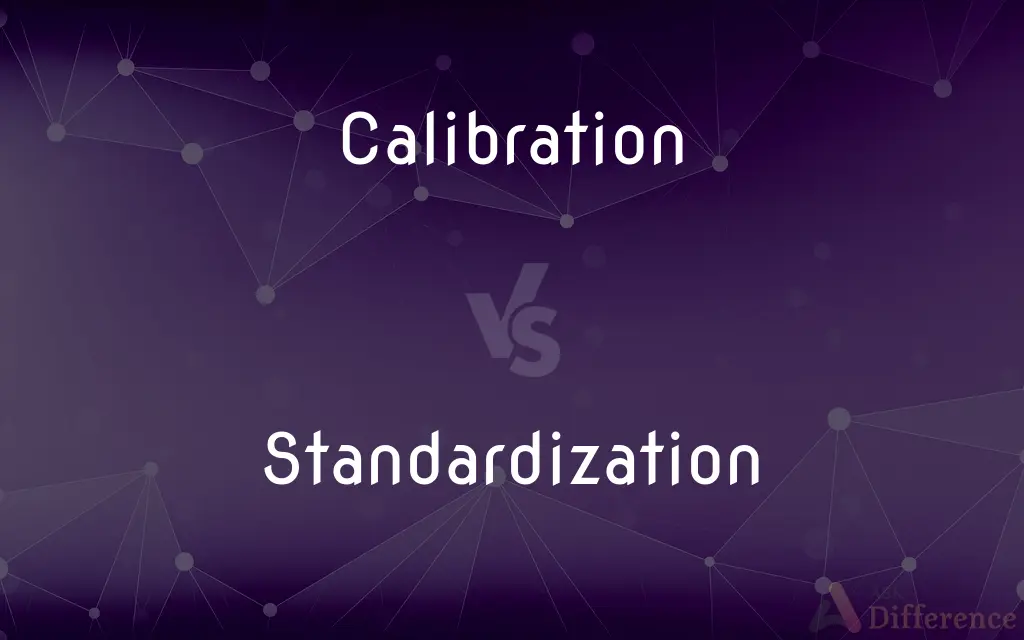Calibration vs. Standardization — What's the Difference?
By Tayyaba Rehman & Fiza Rafique — Updated on March 11, 2024
Calibration adjusts a device to ensure its output matches a known standard, while standardization involves setting uniform practices or criteria across systems or processes.

Difference Between Calibration and Standardization
Table of Contents
ADVERTISEMENT
Key Differences
Calibration is a process typically applied to measuring devices or equipment, where adjustments are made to align its readings with a known and accepted standard or reference point. This ensures accuracy and reliability in measurements, crucial in scientific, manufacturing, and quality control settings. Standardization, on the other hand, refers to establishing and applying uniform standards or norms across various systems, processes, or items, aiming for consistency, compatibility, and interoperability. This can encompass manufacturing processes, quality norms, and even communication protocols.
In the context of quality control, calibration ensures that instruments used for measurements are producing accurate and consistent results, directly impacting product quality and safety. Whereas standardization in quality control sets common benchmarks or criteria that products or processes must meet, facilitating consistency and efficiency across production lines or industries.
When it comes to technology and electronics, calibration might involve setting up a display's color, brightness, and contrast to ensure visual accuracy. In contrast, standardization in this field would involve agreeing on common interfaces, file formats, or communication protocols, ensuring devices and systems can effectively interact and exchange information.
In scientific research, calibration is essential for ensuring that experimental instruments provide accurate data, a cornerstone for valid and reliable research outcomes. Standardization in research, however, might involve using consistent methodologies, definitions, and reporting standards, promoting clarity and enabling comparison and replication of studies.
In the environmental sector, calibration might be used for sensors and instruments monitoring air or water quality, ensuring precise readings that inform policy and health advisories. Standardization, meanwhile, could entail setting universal environmental regulations or metrics, such as emission standards, to address global challenges like climate change and pollution.
ADVERTISEMENT
Comparison Chart
Definition
Adjustment of equipment to match a known standard
Establishing and applying uniform practices or criteria
Application
Measuring devices and instruments
Systems, processes, products
Goal
Ensure accuracy and reliability of measurements
Achieve consistency, compatibility, interoperability
Context Examples
Quality control, scientific research, environmental monitoring
Manufacturing processes, technology protocols, quality norms
Impact
Directly affects the precision of individual instruments or measurements
Influences the overall uniformity and efficiency across systems or industries
Compare with Definitions
Calibration
Process of adjusting measurement tools to match a standard.
The lab technician performed calibration on the pipettes to ensure accurate volume measurements.
Standardization
Adoption of universal benchmarks.
The industry's standardization efforts led to widespread adoption of the new technology.
Calibration
Adjustment for accuracy.
Calibration of the thermometer was crucial for the experiment's temperature readings.
Standardization
Harmonizing systems or components.
Standardization of components across models reduced manufacturing costs and simplified repairs.
Calibration
Setting up devices to produce accurate outputs.
Calibration of the monitor was necessary for color-critical design work.
Standardization
Establishing common standards across processes.
Standardization of manufacturing procedures improved the product's consistency.
Calibration
Aligning equipment with reference values.
The flow meter's calibration involved comparing its readings with a known standard.
Standardization
Implementing consistent norms or specifications.
Standardization of safety protocols enhanced workplace security.
Calibration
Fine-tuning instruments.
The calibration of the spectrophotometer ensured accurate absorbance readings for the samples.
Standardization
Setting uniform criteria or practices.
The standardization of data formats facilitated easier data exchange between systems.
Calibration
In measurement technology and metrology, calibration is the comparison of measurement values delivered by a device under test with those of a calibration standard of known accuracy. Such a standard could be another measurement device of known accuracy, a device generating the quantity to be measured such as a voltage, a sound tone, or a physical artifact, such as a meter ruler.
Standardization
The condition in which a standard has been successfully established;
Standardization of nuts and bolts had saved industry millions of dollars
Calibration
The act or process of calibrating or the state of being calibrated.
Standardization
The imposition of standards or regulations;
A committee was appointed to recommend terminological standardization
Calibration
A gradation that shows a position or value, as on a measuring instrument.
Standardization
Standardization or standardisation is the process of implementing and developing technical standards based on the consensus of different parties that include firms, users, interest groups, standards organizations and governments. Standardization can help maximize compatibility, interoperability, safety, repeatability, or quality.
Calibration
Calibrations A set of such gradations
The calibrations on a pressure gauge.
Standardization
To cause to conform to a standard.
Calibration
The act of calibrating something.
Standardization
To evaluate by comparing with a standard.
Calibration
The process of estimating the caliber a tube, as of a thermometer tube, in order to graduate it to a scale of degrees; also, more generally, the determination of the true value of the spaces in any graduated instrument.
Standardization
The process of complying (or evaluate by comparing) with a standard.
Calibration
The act of checking or adjusting (by comparison with a standard) the accuracy of a measuring instrument;
The thermometer needed calibration
Standardization
The process of establishing a standard.
Standardization
The act of checking or adjusting (by comparison with a standard) the accuracy of a measuring instrument;
The thermometer needed calibration
Common Curiosities
What is calibration?
Calibration involves adjusting or setting instruments and devices to ensure their output or readings align with established standards or reference points for accuracy.
Why is calibration important?
Calibration is crucial for ensuring the accuracy, reliability, and validity of measurements and data produced by instruments, impacting quality control, scientific research, and safety.
What is standardization?
Standardization refers to establishing and applying uniform standards, norms, or criteria across various processes, systems, or products to ensure consistency and interoperability.
Can calibration and standardization coexist?
Yes, calibration and standardization can coexist and complement each other; calibration ensures individual instruments are accurate, while standardization ensures consistency across systems or processes.
What role does standardization play in global markets?
In global markets, standardization plays a key role in facilitating international trade, ensuring product compatibility, and promoting technological interoperability across borders.
How does standardization benefit industries?
Standardization benefits industries by ensuring compatibility, improving efficiency, reducing costs, and facilitating innovation through the adoption of common practices and specifications.
How does standardization impact consumer products?
Standardization impacts consumer products by ensuring safety, compatibility, and reliability, making it easier for consumers to use products from different manufacturers together.
Why is standardization crucial in healthcare?
In healthcare, standardization is crucial for ensuring consistent quality of care, interoperability of medical devices, and compliance with safety and regulatory requirements.
Is calibration only relevant for physical measurements?
While commonly associated with physical measurements, calibration can also apply to software or systems that require accuracy in data processing or output.
Can standardization stifle innovation?
While standardization aims for uniformity, it can sometimes stifle innovation by imposing rigid norms; however, well-designed standards allow for evolution and improvement.
What is the difference between internal and external calibration?
Internal calibration is performed by the instrument's own calibration function or by in-house staff, while external calibration is conducted by an independent, accredited service.
How often should calibration be performed?
The frequency of calibration depends on the instrument's usage, the importance of its measurements, and regulatory or manufacturer guidelines, ranging from monthly to annually.
What is the role of international standards organizations?
International standards organizations, like ISO, develop and publish global standards, facilitating international trade, communication, and technological advancement.
How is calibration verified?
Calibration is verified through comparison with a known reference or standard, often accompanied by certification or documentation that confirms the instrument's accuracy.
What challenges are associated with standardization?
Challenges with standardization include achieving consensus among stakeholders, keeping standards up-to-date with technological advancements, and ensuring they are flexible enough to accommodate diversity and innovation.
Share Your Discovery

Previous Comparison
Thallophyta vs. Bryophyta
Next Comparison
Convection vs. RadiationAuthor Spotlight
Written by
Tayyaba RehmanTayyaba Rehman is a distinguished writer, currently serving as a primary contributor to askdifference.com. As a researcher in semantics and etymology, Tayyaba's passion for the complexity of languages and their distinctions has found a perfect home on the platform. Tayyaba delves into the intricacies of language, distinguishing between commonly confused words and phrases, thereby providing clarity for readers worldwide.
Co-written by
Fiza RafiqueFiza Rafique is a skilled content writer at AskDifference.com, where she meticulously refines and enhances written pieces. Drawing from her vast editorial expertise, Fiza ensures clarity, accuracy, and precision in every article. Passionate about language, she continually seeks to elevate the quality of content for readers worldwide.













































